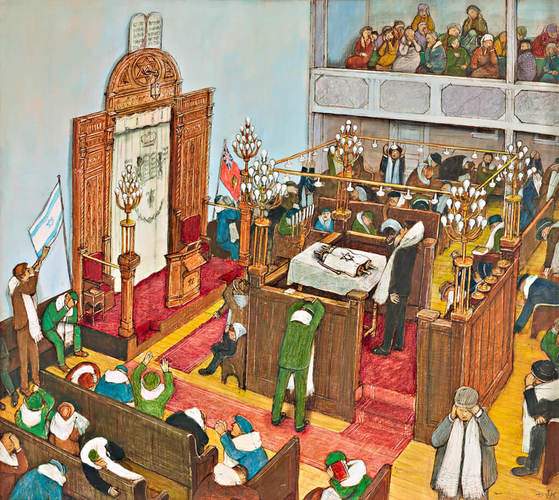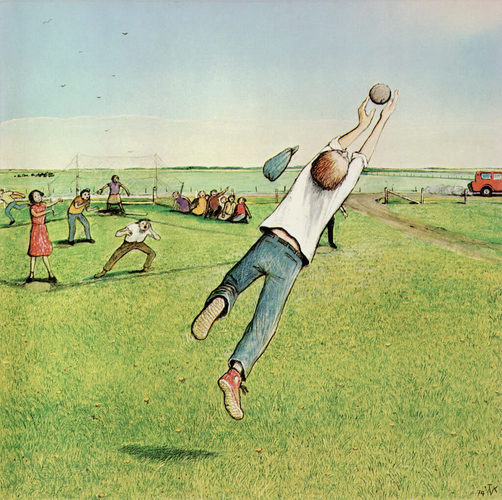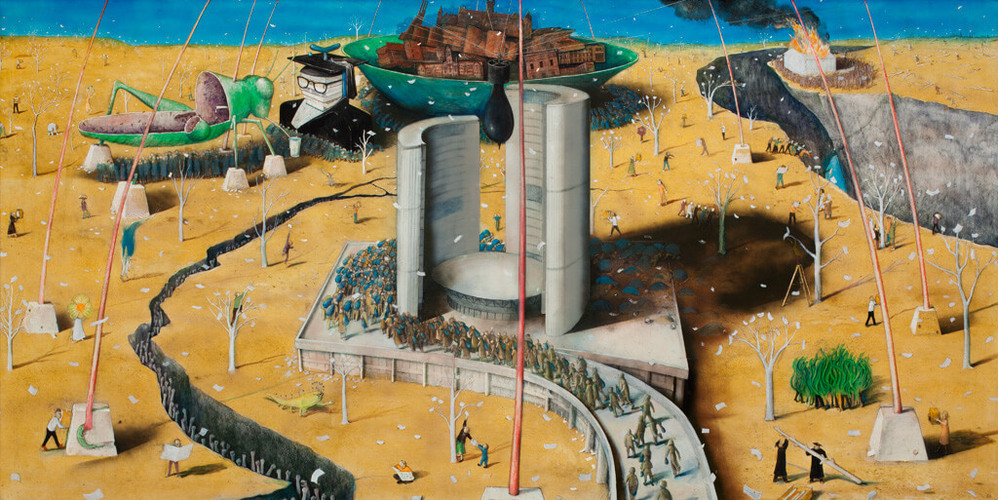No Canadian painter offered a more disparate and ultimately controversial take on his country than William Kurelek (1927–1977). He portrayed Canada as a mosaic of diverse but harmonious cultures that thrived despite historical inequalities, a harsh environment, and a vast, unyielding geography. While creating such scenes, Kurelek also depicted apocalyptic and punishing scenes of disaster—works that raised his critics’ ire.

William Kurelek, Yom Kippur, 1975
Mixed media on board, 50.8 x 57.2 cm, UJA Federation of Greater Toronto. Used as an illustration in William Kurelek and Abraham Arnold, Jewish Life in Canada (1976), 32.
That a certain facet of Kurelek’s creative output was, and remains, popular is easy to understand. His imagery, whether of Ukrainian immigrants toiling on the prairie or of Jewish family life in Montreal, as in the illustration Yom Kippur, 1975, confirmed a progressive view of Canadian society that was strongly resonant between the late 1960s and early 1970s. Yet this was only one aspect of Kurelek’s art.
Throughout his career, Kurelek was never merely the naive, nostalgic, “happy Canadian” who wrote and illustrated award-winning children’s books. As a conservative Roman Catholic living with the looming threat of nuclear war in the 1960s, he believed that a manmade but divinely ordained “purgative catastrophe” was close at hand. And yet though he “damned with terrifying fervor . . . often with disturbingly gruesome images,” as critic Nancy Tousley observed, his “nostalgic side . . . and the work he considered to be ‘potboilers,’” such as his illustrations for A Prairie Boy’s Winter (1973) and A Prairie Boy’s Summer (1975), supported his popularity in the public imagination.

William Kurelek, Skating on the Bog Ditch, 1971
Approximately 33.7 x 33.7 cm, private collection. Used as an illustration in William Kurelek, A Prairie Boy’s Winter (1973).
As Kurelek’s dealer, Avrom Isaacs, believed, his decision to “put God first” made many within the secular art community apoplectic. Some argued that Kurelek’s moral didacticism interfered with the artistic integrity of his work. Others claimed his views were fraudulent. “Where Kurelek fails miserably,” journalist Elizabeth Kilbourn wrote in 1963, “is when he attempts to paint subjects which he knows about only from dogma and not from experience, where in fact he is a theological tourist in never, never land.” Kilbourn’s sentiments were echoed by critic Harry Malcolmson, who three years later penned what became the most infamous rebuke: “the problem with these pictures is that they flow from Kurelek’s imaginings and not from what he knows.” Malcolmson urged Kurelek to concentrate on farm paintings that reflected his upbringing.

William Kurelek, Softball, 1974
Mixed media on Masonite, approximately 33.7 x 33.7 cm, Art Gallery of Windsor, permanent loan from private collection of Hiram Walker and Sons Limited, Walkersville. Used as an illustration in A Prairie Boy’s Summer (1975).
Kurelek’s response to his critics was characteristically indirect. According to his wife, Jean Kurelek, “He was sensitive to criticism but never liked to confront his critics in person,” and would publish a rebuttal or write them a letter. To Malcolmson he explained the source of his conviction: “Our civilization is in crisis and I would be dishonest not to express my concern about my fellow man.” And he added:
Did Hieronymus Bosch, a recognized master in representation of Hell himself go to Hell, and come back before he tackled it? No one has come back from the dead to record his experiences there and yet great classical writers like Milton and Dante waded right into it. Obviously they must draw their experience of those things partly from similar earthly experiences partly from personal or mystical intuition.

William Kurelek, Harvest of Our Mere Humanism Years, 1972
Mixed media on Masonite, 122 x 244 cm, Manulife Art Collection, Toronto
Kurelek ultimately regarded his art as existing outside the contemporary art world, and he unapologetically aligned his didactic “message” paintings, such as Dinnertime on the Prairies, 1963, with the religious and genre art of the Northern Renaissance. Though Kurelek’s work was a product of his Christian world view, the “somber, menacing quality” of it aligned naturally with the social anxiety and existentialism common in the art world during the Cold War era.

William Kurelek, Dinnertime on the Prairies, 1963
Oil on Masonite, 44.7 x 72 cm, McMaster Museum of Art, Hamilton
Despite Kurelek’s detractors, he earned immense respect from secular peers such as Dennis Burton (1933–2013) and Ivan Eyre (b. 1935). Moreover, critical credit from the media and museum professionals came in 1962 after the internationally respected director of the Museum of Modern Art in New York, Alfred H. Barr Jr., acquired a Kurelek painting for the institution’s collection. While Kurelek had his critics, the mainstream press exploded with accolades for the artist following his inaugural exhibition at Isaacs Gallery in Toronto in 1960.
This Essay is excerpted from William Kurelek: Life & Work by Andrew Kear.
 Karen Tam’s Autumn Tigers
Bridging Past and Present: Invisible Made Visible
By Imogene L. Lim, PhD
Karen Tam’s Autumn Tigers
Bridging Past and Present: Invisible Made Visible
By Imogene L. Lim, PhD
 The Frontier Portraits of C.D. Hoy
A Chinese Canadian Photographer’s Tribute to His Community
By Faith Moosang
The Frontier Portraits of C.D. Hoy
A Chinese Canadian Photographer’s Tribute to His Community
By Faith Moosang
 Interrogating Identity
Suzy Lake explores the role of photography in shaping how we understand and see ourselves
By Erin Silver
Interrogating Identity
Suzy Lake explores the role of photography in shaping how we understand and see ourselves
By Erin Silver
 An Emboldened Artist
How Oviloo Tunnillie achieved rare international acclaim as an Inuit female sculptor
By Darlene Coward Wight
An Emboldened Artist
How Oviloo Tunnillie achieved rare international acclaim as an Inuit female sculptor
By Darlene Coward Wight
 Painting the Cultural Mosaic
William Kurelek traversed the country in a quest to capture its diverse inhabitants
By Andrew Kear
Painting the Cultural Mosaic
William Kurelek traversed the country in a quest to capture its diverse inhabitants
By Andrew Kear
 Domestic Discontent
Mary Pratt’s poetic scenes of home life are praised for their political edge
By Ray Cronin
Domestic Discontent
Mary Pratt’s poetic scenes of home life are praised for their political edge
By Ray Cronin
 A New Vision of the North
Annie Pootoogook’s art offers unprecedented insights into the contemporary Arctic
By Nancy G. Campbell
A New Vision of the North
Annie Pootoogook’s art offers unprecedented insights into the contemporary Arctic
By Nancy G. Campbell
 Meetings of Minds
Sorel Etrog found new ideas in collaborative work
By Alma Mikulinsky
Meetings of Minds
Sorel Etrog found new ideas in collaborative work
By Alma Mikulinsky
 Introducing Miss Chief
An excerpt from the ACI’s book “Revision and Resistance”
By Shirley Madill
Introducing Miss Chief
An excerpt from the ACI’s book “Revision and Resistance”
By Shirley Madill
 A Practice of Recovery
An excerpt from the ACI’s book “Revision and Resistance”
By Sasha Suda
A Practice of Recovery
An excerpt from the ACI’s book “Revision and Resistance”
By Sasha Suda
 Decolonizing History Painting
An excerpt from the ACI’s book “Revision and Resistance”
By Ruth B. Phillips and Mark Salber Phillips
Decolonizing History Painting
An excerpt from the ACI’s book “Revision and Resistance”
By Ruth B. Phillips and Mark Salber Phillips
 A Vision for the Future
An excerpt from the ACI’s book “Revision and Resistance”
By Nick Estes
A Vision for the Future
An excerpt from the ACI’s book “Revision and Resistance”
By Nick Estes
 Inside Kent Monkman’s Studio
An excerpt from the ACI’s book “Revision and Resistance”
By Jami C. Powell
Inside Kent Monkman’s Studio
An excerpt from the ACI’s book “Revision and Resistance”
By Jami C. Powell
 The Rule of Chance
Jean Paul Riopelle’s break with Automatism
By François-Marc Gagnon
The Rule of Chance
Jean Paul Riopelle’s break with Automatism
By François-Marc Gagnon
 From Taos to New York
Agnes Martin and the currents of American Art
By Christopher Régimbal
From Taos to New York
Agnes Martin and the currents of American Art
By Christopher Régimbal
 An Artist Blooms
Mary Hiester Reid’s floral aesthetics
By Andrea Terry
An Artist Blooms
Mary Hiester Reid’s floral aesthetics
By Andrea Terry
 The Patriotic Painter
Greg Curnoe’s Canada
By Judith Rodger
The Patriotic Painter
Greg Curnoe’s Canada
By Judith Rodger
 Walking, Stacking, Dancing
Françoise Sullivan’s conceptual 1970s
By Annie Gérin
Walking, Stacking, Dancing
Françoise Sullivan’s conceptual 1970s
By Annie Gérin
 The Extraordinary North
Tom Thomson’s diary of landscape
By David P. Silcox
The Extraordinary North
Tom Thomson’s diary of landscape
By David P. Silcox
 A Champion of Abstraction
Jock Macdonald sought a new expression in art
By Joyce Zemans
A Champion of Abstraction
Jock Macdonald sought a new expression in art
By Joyce Zemans